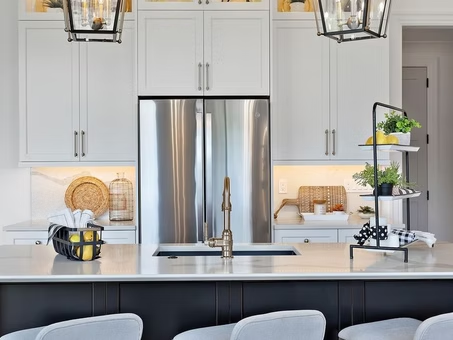Exploring Unique Alternatives to Traditional Cabinet Door Styles for Your Home Makeover
In the realm of home design, cabinet door styles play a pivotal role in defining the character and functionality of kitchen and storage spaces. While traditional cabinet doors have long been the go-to option for many homeowners, the desire for unique and personalized interiors has led to the exploration of unconventional alternatives. This blog aims to delve into innovative cabinet door styles that go beyond the classic designs, offering fresh perspectives for those looking to revamp their homes. From farmhouse-inspired sliding doors to sleek, modern materials, the possibilities are endless. As we navigate through this exciting landscape of alternatives, readers will discover creative options that not only enhance aesthetic appeal but also cater to practical needs, ultimately transforming their living spaces into reflections of their unique tastes.

Exploring the Rise of Minimalist Cabinet Designs in Modern Interiors
In recent years, minimalist cabinet designs have surged in popularity, reflecting a broader trend towards simplicity and functionality in modern interiors. According to a report by Allied Market Research, the global kitchen cabinets market was valued at approximately $75 billion in 2020 and is projected to reach over $114 billion by 2027, with a notable shift towards minimalist styles. These designs not only cater to the aesthetic desires of homeowners but also align with the increasing demand for efficient and sustainable living spaces.
One of the key factors driving this trend is the emphasis on open spaces and uncluttered environments. A study published by the National Kitchen & Bath Association indicated that 75% of homeowners prefer a clean and streamlined look in their kitchens, supporting the rise of handleless cabinets and integrated appliances. This minimalist approach not only enhances the visual appeal but also allows for greater versatility in interior design, making it easier to adapt spaces as trends evolve. Additionally, the use of high-quality materials with simple finishes contributes to durability while maintaining a contemporary feel. As minimalist cabinet designs continue to dominate, they redefine how we perceive storage and functionality within our homes.
The Impact of Color Trends on Cabinet Door Styles in Home Renovations
As home renovations gain momentum, the impact of color trends on cabinet door styles becomes increasingly significant. According to industry reports, the global hair care market is projected to reach $213.47 billion by 2032, growing at a compound annual growth rate of 9.4% from 2025. This growth reflects an overarching trend where color influences various sectors, including home design. The 2025 color trend report highlights "earthy tones" and "future twilight" as key palettes that will dominate, encouraging homeowners to rethink traditional cabinet styles in favor of warmer, more rustic hues that resonate with nature.
The shift towards warmer colors not only enhances aesthetics but also creates a sense of comfort and connection to the environment. As brands leverage these emerging color trends, they provide consumers with unique alternatives to conventional cabinet door styles. For instance, the popular "Mocha Mousse" has been projected as a defining color for 2025, allowing designers to infuse homes with a new, vibrant personality. This strategic alignment with color trends could ultimately transform cabinet designs, making them more than just functional elements but focal points that reflect personal style and contemporary trends.
Innovative Materials: How Composite and Reclaimed Wood Are Reshaping Cabinet Design
In the realm of home design, innovative materials are redefining cabinet door styles. Composite wood, which combines various wood fibers and resins, offers remarkable durability and a range of finishes that can suit any aesthetic preference. Its resistance to warping and moisture makes it a practical choice for kitchens and bathrooms, where humidity levels can fluctuate. By incorporating composite materials, homeowners can achieve sleek, modern looks without sacrificing functionality.
On the other hand, reclaimed wood brings a unique character to cabinetry. Sourcing wood from old barns, factories, or furniture not only gives cabinets a distinctive vintage appeal but also promotes sustainability. Each piece of reclaimed wood has its own history and charm, allowing for truly one-of-a-kind cabinet designs. Additionally, the use of reclaimed wood supports eco-friendly practices, making it an attractive option for environmentally conscious homeowners looking to make a bold design statement.
Together, composite and reclaimed wood highlight a trend toward creativity and sustainability in cabinet design, offering homeowners the chance to personalize their spaces in innovative ways.
Understanding Consumer Preferences: Data on Custom vs. Pre-made Cabinet Styles
When it comes to home makeovers, the choice of cabinet doors is often an afterthought, overshadowed by paint colors and flooring options. However, understanding consumer preferences reveals a significant trend towards custom cabinet styles. Recent surveys indicate that homeowners are increasingly valuing personalization over mass-produced options. This demand for unique designs allows individuals to express their personal style and cater to specific needs, transforming the kitchen or living space into a truly customized environment.
Data shows that a considerable percentage of homeowners feel that pre-made cabinets lack the character and functionality that custom solutions can provide. Custom cabinets can be tailored in terms of dimensions, materials, and finishes, allowing them to fit seamlessly into any space, regardless of its quirks. This not only enhances the aesthetic appeal but also maximizes storage efficiency. As trends in interior design continue to evolve, it is clear that consumers are gravitating towards options that provide not just a functional advantage but a unique story behind their cabinet choices.
The Role of Eco-friendly Solutions in Shaping the Future of Cabinet Design Trends
As homeowners increasingly prioritize sustainability, eco-friendly solutions are emerging as a driving force in cabinet design trends. According to a recent report from the National Kitchen and Bath Association, nearly 70% of consumers are willing to pay more for environmentally responsible products. This shift towards green materials not only addresses environmental concerns but also enhances the aesthetic appeal of kitchens and living spaces. Options such as bamboo, reclaimed wood, and low-VOC finishes are becoming popular choices, allowing homeowners to create beautiful interiors while minimizing their carbon footprint.
When considering a kitchen or home makeover, it's crucial to look for materials that contribute to sustainability. One tip is to choose cabinets made from certified sustainable wood, which ensures responsible forestry practices. Additionally, exploring local manufacturers can further reduce transportation emissions and support the community. Lastly, consider finishes that emit fewer harmful chemicals, contributing to better indoor air quality and a healthier home environment.
Investing in eco-friendly cabinet designs is not only a trend but a commitment to a sustainable future. Homeowners can create stunning spaces that reflect personal style while actively participating in the broader movement towards environmental stewardship. By making informed choices about materials and finishes, you can enhance your home’s aesthetic and contribute to a healthier planet.
Exploring Unique Alternatives to Traditional Cabinet Door Styles
Related Posts
-

Mastering Cabinet Door Styles with Detailed Technical Specs and Comprehensive Installation Guide
-

Top 5 Global Certifications for Kitchen Cabinet Door Styles You Must Know
-

Cabinet Styles Shine at the 137th Canton Fair with Record International Buyer Attendance
-

What Makes New Cabinets a Game Changer in Global Supply Standards
-

How to Identify Quality Manufacturers for the Best Cabinet Styles You Desire
-

Unlocking Global Trade Compliance: How to Choose the Latest Kitchen Cabinet Colors for Export Success


Fall into Function: How LaFata Cabinets Prepares Your Kitchen for the Cozy Season


Back-to-School Kitchen Refresh: How LaFata Cabinets Can Help You Stay Organized This Fall


